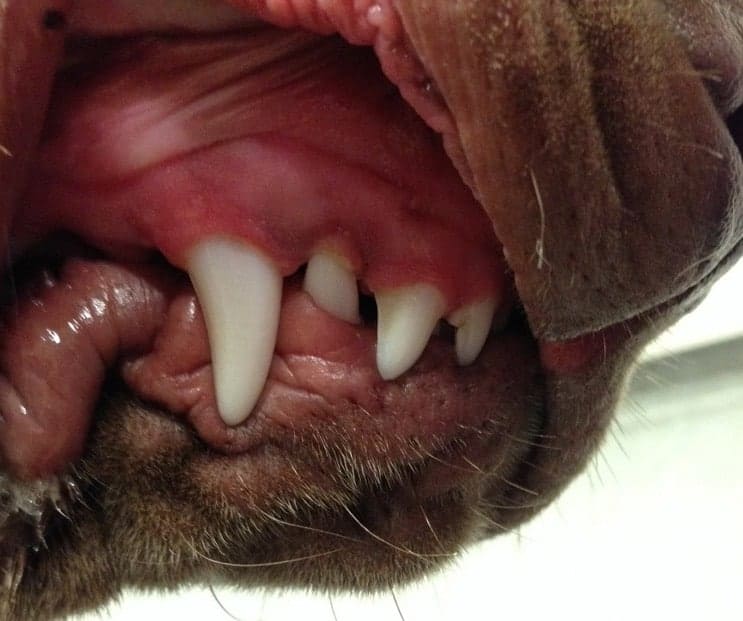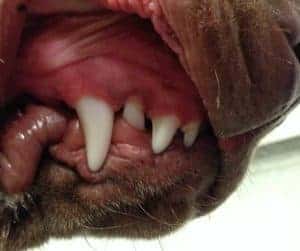
‘Base narrow canines’ is one of the most common conditions that I get called about in puppies. The technical name for it is ‘linguoverted canines’. This problem arises a couple of different ways. One is where the lower jaw is the right length but the lower canines (or fangs) erupt too vertically, so they hit the upper gum tissue instead of clearing the upper jaw to the sides. The second way is that the lower jaw is too short, so the lower canines get caught between the upper canines as they erupt, and are forced to follow a narrow path up into the palate. The basic outcome is that the two lower fangs are hitting the roof of the mouth, causing pain and trauma.
Affected dogs bite themselves every time they close their mouths – that’s 100, 200, 300 times a day. These teeth are very big, sharp and the jaws are very powerful. It’s really painful for these dogs to be biting themselves every time they close their mouths. It really, really hurts!
Breeds most commonly affected by base narrow canines include:
- Poodles
- Cavoodles
- Staffordshire Bull terriers
- English Bull terriers
- Dachshunds
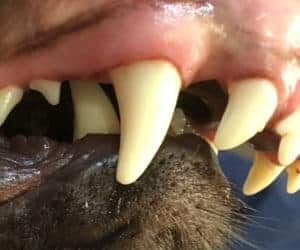
The lower jaw is too short. The lower canine is digging into the hard palate – ouch!! - Labradors
- Weimaraners
- Rottweilers
- Greyhounds
Base Narrow Canines Are Common But Can Be Hard To Notice
Base narrow canines are one of the most common calls that we get for young dogs. We do see it in cats as well but not as regularly. When we see it, one of the things that people are really worried about is whether their animal might be in pain.
“Well if my dog is still eating it can’t really be that sore, can it?” This is a very confusing and honest misconception.
The thing is that these dogs develop base narrow canines when they’re really young. These animals really don’t know any better. It’s always hurt when they close their mouths, ever since their teeth erupted. They’ve always known it to be sore when they close their mouths.
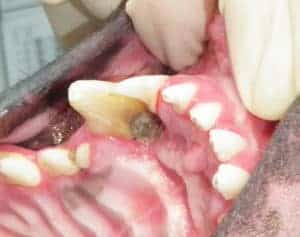
What Happens If We Don’t Treat Base Narrow Canines?
Dogs have to eat – if they don’t they will starve to death. For these dogs eating has always been a painful thing. It forces them to just get on with it and not really whinge about eating.
Strangely, these puppies actually like to chew a lot more than normal puppies. This can be confusing too. I ask owners, “does your puppy chew a lot?” and they say “oh my goodness, he chews everything he can get into his mouth.”
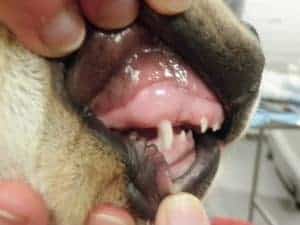
Why Puppies Chew A Lot When They Have Base Narrow Canines
If it was me, I would think, if I had a puppy that chewed a lot, maybe it isn’t really that sore. However, the thing is that while the puppy has something in its mouth, that actually stops it from closing its mouth fully, so it’s not going to be biting itself. So this pup will commonly have a toy, stick, rock, your hand, a shoe, a jumper or anything in its mouth – then when it closes its mouth it’s not going to hurt! When puppies usually grow out of the chewing phase, these dogs won’t grow out of it. They will chew everything and it can actually be an issue for them and for their owners if expensive pieces of clothing or furniture are involved.
See the testimonial on Destructive Chewing In Dogs
Social Changes
We know that base narrow canines are painful throughout a dog’s life. This is particularly true during social development (when they’re learning to be a social animal).
- When dogs are learning their behaviour, they’re learning their manners.
- If the dog has a sore mouth and somebody goes near their mouth, it can affect their behaviour for the rest of their life. They can become head-shy, or even aggressive. These dogs can grow up to have real issues.
Permanent Damage If Not Treated
Dogs with base narrow canines will develop varying degrees of damage to the gum, palate and surrounding tissues over time. In addition to being sore every day, dogs can get permanent damage.
Daisy’s Story
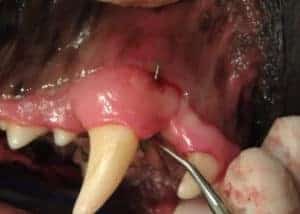
A little dog that really brought this home for me was Daisy. She was 5 years old, and she came in because she had an abscess on the side of her face – into her nose and her upper jaw.
Daisy did not have a problem with her upper jaw to start with. It actually started because her lower canines were base narrow, or linguoverted, and so they had been driving up into her hard palate. This made holes in the roof of her mouth that had caused infection over the years. The infection tracked up the inside of her upper canines. It had actually burrowed all the way up into her nose and had burst out through the side of her face.
This little dog had been in pain for years but because she didn’t like anybody looking in her mouth, everyone thought “well, she just doesn’t like having her mouth looked at”. Importantly, she’d eaten every day of her life. Yet she ended up so sore that she had no choice but to stop eating.
Daisy’s Treatment
When this abscess blew out, the owners were really, really upset because they loved Daisy as part of the family. They couldn’t believe they’d missed this problem for so long. The thing is that dogs are so good at hiding pain from us. Daisy’s people weren’t bad owners at all – they loved Daisy to pieces, she was part of the family. Yet she’d managed to hide this problem for years.
So what is the important thing to do with base narrow canines in your dog? If you have any suspicion that your dog may have this problem, go to your vet, get it checked out. Make sure your vet checks your puppy’s mouth at vaccinations and desexing. Affected dogs may not let the vet have a really good look in the mouth. If so, then it might be a matter of sedation to have a look and make sure there’s nothing painful going on.
Baby Teeth Or Adult Teeth?
The two times we tend to see base narrow canines are:
- Adult teeth – from 6 months of age.
- Baby teeth – prior to 6 months of age. Sometimes, intervening when they’ve got their baby teeth can affect what the adult teeth are going to do.
Treating Base Narrow Canines In Dogs
Every Pet Deserves A Healthy, Pain-Free Mouth
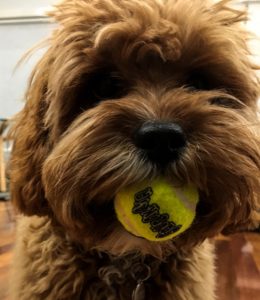
So if we know that there are base narrow canines, we can make it healthy, we can make it pain-free. Remember the Sydney Pet Dentistry motto “Every pet deserves a healthy pain-free mouth”.
A dog doesn’t need to have a normal mouth. Sometimes we can give them a normal bite depending on the problem and how it’s developed. Sometimes we can’t give them a normal bite, but a dog doesn’t need to have a normal bite to be happy, healthy and functional.
The other dogs in the park aren’t going to laugh at your dog because it hasn’t got all of its teeth or because its teeth are crooked. Dogs really don’t worry about that kind of thing. My own dog Jack actually had this problem and he hasn’t got a normal bite now. We weren’t able to make his bite normal, but he’s certainly comfortable, he’s functional, he can eat, he can open and close his mouth fully. He can play, he can carry his ball, all of that is fine. And none of the other dogs at the park have even noticed that his mouth isn’t normal. He still looks very handsome too!
The good news is that we can do something with each of these dogs – we can always make them comfortable. Whether all of the teeth are there and in the right position, is a secondary thing. We need to know the problem’s there to start with. You need to get it checked out with your vet and make sure that it’s okay.
What Can You Do If Your Dog Has Base Narrow Canines?
The first thing is to look and remember that we need to treat if we’ve got an infection or we’ve got pain – if it’s hurting your animal, we need to do something about it. We don’t want your animal to have a life-long problem with pain and damage. There are always options – an animal does not need to live in pain with this condition. Here are some options:
Move The Teeth Into A Normal Position
This is what people think of as typical orthodontics – it might be using braces or it may be using a plate, or sometimes even something as simple as a thing called ball therapy, where we get them to chew on a ball. This depends on the way the mouth fits together, and it only works in very specific cases, but if that’s an option, ball therapy can be a very cheap and easy treatment and that’s why you need to get a good assessment early on – to work out if this is something that might work for your dog.
Make The Lower Canines Shorter
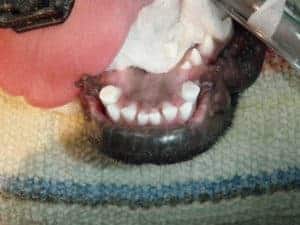
If we can’t move the teeth into a good position then we might be able to keep them where they are but take the tips off them. This means that they are not hitting the roof of the mouth, and not causing pain.
This is a surgical procedure because we need to put fillings into the teeth – we can’t just chop the tops off and leave them open because the pulp tissue (which is the living tissue inside the tooth, or what people think of as the nerve tissue) will die. Exposing tooth nerve tissue (and not filling it) is incredibly painful and you will end up with an abscess under the tooth, so we need to do that surgically and put fillings into the tooth.
Take The Lower Canines Out
This is a surgical procedure and can be very effective and simple in some cases. It can sometimes weaken the bone of the lower jaw. Jack the cavoodle in the picture above had a lower canine removed.
Remove The Puppy Canines
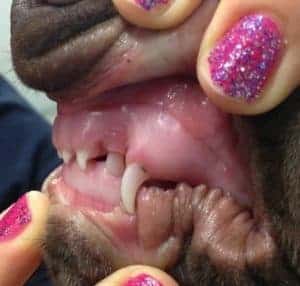
You may see base narrow canines in your puppy when they’ve still got their baby teeth. In a lot of cases, this is causing pain and we recommend taking those baby teeth out. This will stop the pain pretty much instantly.
Which Option To Choose?
All of these options have pros and cons, so that’s something we can go through in a consultation. It depends on the way the mouth fits together. Other factors such as how much follow-up you’re going to need and issues beyond the scope of this article are also considered.
The 3D Puppy Puzzle
Occasionally we may be able to improve the chance of the adult teeth coming out in a better position by intervening when they are a puppy. This depends on the way the mouth fits together, the problem the dog has, the growth rate and if the dog has puppy teeth or not. Consequently, we may be able to decrease the risk of having surgery or a procedure done with adult teeth. We need to assess the puppy’s mouth in 3D to work out what is likely to happen in any case, and it is always up to mother nature and genetics to guide the final outcome.
The Final Word
The bottom line is that we can always do something. If you do have base narrow canines in your puppy… or you suspect it, get it checked out. It is something that can cause life-long pain and damage to your dog. Yet if it’s treated, your dog can be permanently and instantly feeling a lot better. It’s one of those things we can do a lot about and get a really good result.
An animal doesn’t need to have a perfect smile or all of its teeth in exactly the right position, but it does need to be comfortable and it does need to be functional, and that’s what we’re here to achieve.
